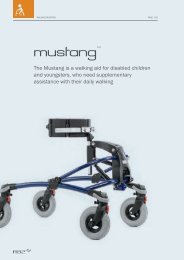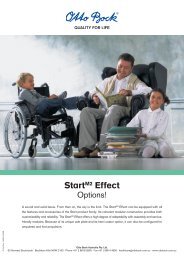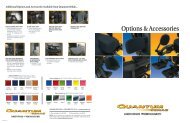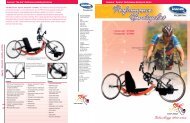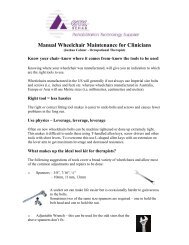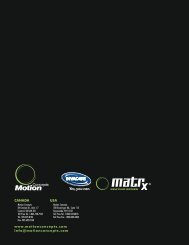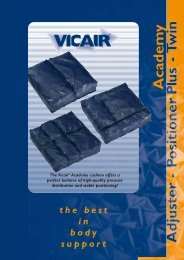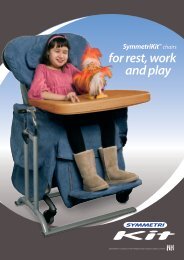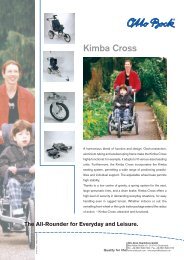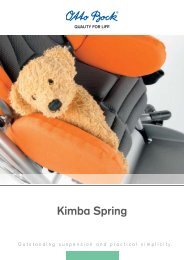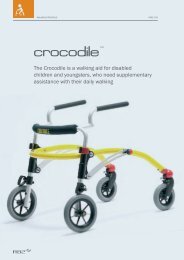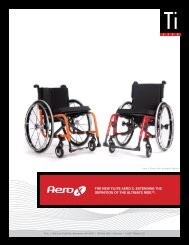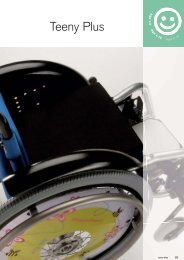Dynamic vs Rigid Seat System in Cerebral Palsy ... - GTK Rehab
Dynamic vs Rigid Seat System in Cerebral Palsy ... - GTK Rehab
Dynamic vs Rigid Seat System in Cerebral Palsy ... - GTK Rehab
Create successful ePaper yourself
Turn your PDF publications into a flip-book with our unique Google optimized e-Paper software.
<strong>Dynamic</strong> <strong>Seat</strong> <strong>System</strong> Evaluation<br />
<strong>Dynamic</strong> <strong>vs</strong> <strong>Rigid</strong> <strong>Seat</strong> <strong>System</strong><br />
<strong>in</strong> <strong>Cerebral</strong> <strong>Palsy</strong>:<br />
quantitative comparison<br />
WE TAKE CARE
2<br />
WE TAKE CARE<br />
Valutazione di un Sistema<br />
di Seduta D<strong>in</strong>amico<br />
<strong>Dynamic</strong> <strong>Seat</strong> <strong>System</strong><br />
Evaluation<br />
VALUTAZIONE QUANTITATIVA COMPARATIVA TRA SISTEMA DI SEDUTA RIGIDO E SISTEMA DI SEDUTA DINAMICO IN<br />
PAZIENTI AFFETTI DA TETRAPARESI SPASTICO-DISTONICA<br />
QUANTITATIVE COMPARISON BETWEEN RIGID SEAT SYSTEM AND DYNAMIC SEAT SYSTEM USING 3D<br />
MOVEMENT ANALYSIS IN DYSTONIC PATIENTS WITH CEREBRAL PALSY<br />
Luigi Picc<strong>in</strong><strong>in</strong>i 1 , Veronica Cimol<strong>in</strong> 2 , Mart<strong>in</strong>o Avellis 3 , Andrea Cazzaniga 3 , Anna Carla Turconi 1 , Marcello Crivell<strong>in</strong>i 2 ,<br />
Manuela Galli 2 , 4<br />
1<br />
IRCCS Medea – La Nostra Famiglia, Bosisio Par<strong>in</strong>i (LC), Italia<br />
2<br />
Dipartimento di Bio<strong>in</strong>gegneria, Politecnico di Milano, Milano, Italia<br />
3<br />
Dipartimento di Ricerca e Formazione “Fumagalli srl”, Pontelambro (CO), Italia<br />
4<br />
IRCCS “San Raffaele Pisana” e Casa di cura “San Raffaele Cass<strong>in</strong>o” - Tos<strong>in</strong>vest Sanità, Roma, Italia
<strong>Dynamic</strong> <strong>Seat</strong> <strong>System</strong> Evaluation<br />
3<br />
“<br />
Innovare vuol dire rischiare la delusione.<br />
Ma il rischio va affrontato perchè il massimo<br />
rischio nella vita è di non rischiare mai.<br />
Soltanto chi rischia può raggiungere mete<br />
straord<strong>in</strong>arie.<br />
Innovate means risk<strong>in</strong>g disappo<strong>in</strong>tment.<br />
But the risk must be faced because<br />
the greatest risk <strong>in</strong> life is not to risk.<br />
Only those who risk can achieve<br />
extraord<strong>in</strong>ary goals.<br />
“
4<br />
Introduzione<br />
Innovazione e qualità sono concetti che caratterizzano le performance delle aziende<br />
più d<strong>in</strong>amiche e capaci di rispondere alle sfide del mercato. L’orig<strong>in</strong>e di questi due<br />
elementi è la ricerca scientifica che viene fatta <strong>in</strong> un’azienda, che ha come obiettivo<br />
la correlazione tra quelle che sono le necessità del dest<strong>in</strong>atario ultimo del prodotto e<br />
le caratteristiche offerte dal prodotto stesso. Per la Fumagalli fare ricerca e, conseguentemente,<br />
formazione non è, qu<strong>in</strong>di, casuale: risponde all’esigenza di migliorare<br />
l’efficacia di ausili dest<strong>in</strong>ati a persone con disabilità. Così come non casuale, <strong>in</strong> merito<br />
allo studio presentato <strong>in</strong> questo fascicolo, è stata la scelta della partnership con<br />
cui la ricerca è stata condotta: l’IRCCS “E.Medea” Associazione La Nostra Famiglia<br />
di Bosisio Par<strong>in</strong>i (Lc), uno dei più importanti e prestigiosi Centri riabilitativi di<br />
cura e ricerca delle patologie e disabilità <strong>in</strong>fantili e il laboratorio di Bio<strong>in</strong>gegneria<br />
“L.Divieti” del Politecnico di Milano, la cui fama è altrettanto nota. L’unione di diverse<br />
competenze (cl<strong>in</strong>ico-riabilitative, tecniche, <strong>in</strong>gegneristiche e matematiche) ha<br />
permesso di condurre lo studio con rigore e di elaborare <strong>in</strong>formazioni preziose.<br />
I risultati della ricerca sono stati presentati durante i lavori del 25° International <strong>Seat</strong><strong>in</strong>g<br />
Symposium a Orlando (USA), durante i lavori del 2° European <strong>Seat</strong><strong>in</strong>g Symposium,<br />
nel corso dei lavori del congresso <strong>in</strong>tersocietario della sezione pediatrica della<br />
SIMFER “La riabilitazione nelle malattie ad <strong>in</strong>teressamento multisistemico nell’<strong>in</strong>fanzia:<br />
un approccio multidiscipl<strong>in</strong>are”, tenutosi a Bosisio Par<strong>in</strong>i nel 2008 ed <strong>in</strong> altri<br />
convegni <strong>in</strong> Italia.<br />
L’articolo è stato <strong>in</strong>oltre pubblicato sul testo: “DAAM Scientific Book 2009” ed è <strong>in</strong><br />
fase di pubblicazione sulla rivista <strong>in</strong>ternazionale“Disability and <strong>Rehab</strong>ilitation: Assistive<br />
Technology”.<br />
Siamo certi che gli sforzi dedicati a questo genere di attività all’<strong>in</strong>terno di un’azienda<br />
come la Fumagalli, possano dare il riscontro positivo che rimane uno dei nostri obiettivi<br />
primari: il miglioramento della qualità della vita dei nostri utenti.
<strong>Dynamic</strong> <strong>Seat</strong> <strong>System</strong> Evaluation<br />
5<br />
Introduction<br />
Innovation and quality are concepts that dist<strong>in</strong>guish the performance of the most dynamic<br />
companies ready to face the new challenges of the market. The scientific research<br />
carried out by the company is at the source of both these concepts, the ma<strong>in</strong> task of<br />
which is the correlation between the end user’s needs and the features of the product<br />
itself. In Fumagalli, research, and consequently, tra<strong>in</strong><strong>in</strong>g, are the best answer to improve<br />
the effectiveness of aids for the disabled. It is not by chance that we choose the<br />
partnership of IRCCS “E. Medea” Associazione La Nostra Famiglia <strong>in</strong> Bosisio Par<strong>in</strong>i<br />
(Lc), one of the most important and prestigious centres for care and rehabilitation <strong>in</strong><br />
child pathologies and disabilities and of the Bioeng<strong>in</strong>eer<strong>in</strong>g Laboratory “L. Divieti”<br />
of the Polytechnic <strong>in</strong> Milan, whose stature is as much renowned. The comb<strong>in</strong><strong>in</strong>g of<br />
different skills (cl<strong>in</strong>ical-rehabilitative, technical, eng<strong>in</strong>eer<strong>in</strong>g and mathematical) have<br />
led to precise research and enabled the elaboration of precious <strong>in</strong>formation.<br />
The research results have been presented at the workshop of the 25° International<br />
<strong>Seat</strong><strong>in</strong>g Symposium <strong>in</strong> Orlando (USA), at the workshop of the 2° European <strong>Seat</strong><strong>in</strong>g<br />
Symposium <strong>in</strong> Dubl<strong>in</strong>, at the workshop of Intersociety Congress of the paediatric section<br />
of SIMFER “The rehabilitation of children with multisystemic illnesses: a multidiscipl<strong>in</strong>ary<br />
approach”, held <strong>in</strong> Bosisio Par<strong>in</strong>i <strong>in</strong> 2008 and at many other conventions<br />
<strong>in</strong> Italy.<br />
The article has also been published <strong>in</strong> the “DAAM Scientific Book 2009” and will<br />
appear <strong>in</strong> pr<strong>in</strong>t <strong>in</strong> the <strong>in</strong>ternational journal “Disability and <strong>Rehab</strong>ilitation: Assistive<br />
Technology”.<br />
We are certa<strong>in</strong> that the efforts dedicated to this activity with<strong>in</strong> a company such as<br />
Fumagalli can br<strong>in</strong>g about the positive feedback that is one of our ma<strong>in</strong> goals: the<br />
improvement <strong>in</strong> the quality of life of our users.
6<br />
Riassunto<br />
In diverse condizioni patologiche, come nella Paralisi<br />
<strong>Cerebral</strong>e Infantile sono presenti movimenti di “fondo”,<br />
cioè movimenti che perturbano l’equilibrio del paziente.<br />
Per migliorarne la stabilità posturale sono stati<br />
sviluppati sistema di seduta con schienale d<strong>in</strong>amico. In<br />
questo studio è stata valutata quantitativamente la strategia<br />
biomeccanica (<strong>in</strong> term<strong>in</strong>i di c<strong>in</strong>ematica e di distribuzione<br />
di pressione) di 10 soggetti con tetraparesi spastica<br />
distonica posturati su un sistema di seduta <strong>in</strong> due<br />
sessioni: con schienale nella configurazione rigida e<br />
nella configurazione d<strong>in</strong>amica. Dai dati ottenuti si sono<br />
identificati e calcolati alcuni parametri atti a quantificare<br />
le differenze tra le due configurazioni di schienale. I<br />
risultati ottenuti mostrano che nella configurazione d<strong>in</strong>amica<br />
l’escursione del movimento del tronco nella direzione<br />
antero-posteriore è maggiore, si evidenzia una<br />
m<strong>in</strong>or tendenza a scivolare verso il basso, un limitato<br />
fenomeno di irradiazione a livello degli arti superiori e<br />
una riduzione delle forze compressive a cui il paziente<br />
è sottoposto a livello del tronco. Questi risultati relativi<br />
al sistema di seduta regolato nella configurazione d<strong>in</strong>amica<br />
sono significativi di un <strong>in</strong>cremento del confort e<br />
della qualità della stabilità posturale del paziente.<br />
Abstract<br />
High-tone extensor thrust or <strong>in</strong>voluntary muscle contractions<br />
experienced by many children with <strong>Cerebral</strong><br />
<strong>Palsy</strong> with severe dystonia, can cause a host of problems<br />
for the patients relat<strong>in</strong>g to the seat<strong>in</strong>g system.<br />
To improve postural stability the concept of a dynamic<br />
seat has been suggested as a potential solution. In this<br />
study a quantitative comparison of a dynamic seat system<br />
versus a rigid seat system <strong>in</strong> 10 dystonic patients<br />
with <strong>Cerebral</strong> <strong>Palsy</strong>, us<strong>in</strong>g quantitative analysis of movement<br />
(3D k<strong>in</strong>ematics and pressure distribution) was<br />
conducted.<br />
The obta<strong>in</strong>ed results demonstrate that the seat<strong>in</strong>g system<br />
<strong>in</strong> the dynamic configuration is able to reduce the<br />
forces experienced by the patients, as well as to <strong>in</strong>crease<br />
the range of motion <strong>in</strong> the anterior-posterior direction,<br />
limit<strong>in</strong>g the roll<strong>in</strong>g down of the trunk and show<strong>in</strong>g<br />
a better upper limb smoothness dur<strong>in</strong>g the extensor<br />
thrust. This can lead to an <strong>in</strong>creased occupant comfort<br />
and quality of postural stability.<br />
Parole chiave<br />
Sistema di seduta d<strong>in</strong>amico, distonia, c<strong>in</strong>ematica, distribuzione<br />
di pressione<br />
Keywords<br />
<strong>Dynamic</strong> seat system, dystonia, k<strong>in</strong>ematics, pressure<br />
distribution
<strong>Dynamic</strong> <strong>Seat</strong> <strong>System</strong> Evaluation 7<br />
Introduzione e scopo del lavoro<br />
La distonia è un disturbo del movimento caratterizzato da contrazioni muscolari prolungate che<br />
possono <strong>in</strong>teressare uno o più segmenti corporei e che determ<strong>in</strong>ano la comparsa di movimenti torsionali<br />
e posture anomale. Diverse condizioni patologiche, quali alcune forme di Paralisi <strong>Cerebral</strong>e<br />
Infantile, presentano componenti distoniche che tendono a perturbare l’equilibrio del paziente<br />
con notevole difficoltà nel mantenimento della stabilità sui diversi sistemi di seduta. Questo porta<br />
spesso a destabilizzazione dell’<strong>in</strong>tero assetto posturale con conseguenze negative anche <strong>in</strong> term<strong>in</strong>i<br />
di aspetti funzionali. Durante tali movimenti, <strong>in</strong>fatti, il paziente esercita delle forze significative<br />
sulla seduta e sull’appoggiapiedi, portando all’<strong>in</strong>sorgere di diverse problematiche. Per esempio,<br />
se la seduta della poltrona non è ben imbottita possono verificarsi dei fenomeni di attrito tra la<br />
superficie cutanea e la seduta o lo schienale, provocando fastidio e dolore al paziente. Si possono<br />
verificare anche dei problemi a livello circolatori dovuti alla postura fissa del soggetto, portando<br />
così a cont<strong>in</strong>ui movimenti di riposizionamento del soggetto sul sistema di seduta. D’altra parte<br />
bloccare completamente uno o più segmenti corporei di un soggetto distonico implicherebbe<br />
un’irradiazione della componente disc<strong>in</strong>etica negli altri distretti. Inoltre bisogna tener conto che<br />
il carico e lo scarico meccanico del sistema di seduta che avviene durante tali movimenti ciclicamente<br />
può <strong>in</strong>fluire negativamente sulla durata di tali sistemi. Sarebbe pertanto auspicabile l’<strong>in</strong>dividuazione<br />
di un ausilio che consenta un discreto contenimento del paziente, ma che permetta allo<br />
stesso tempo l’assorbimento delle distonie limitando anche i problemi di irradiazione.<br />
Le ricerche sull’argomento risalgono agli <strong>in</strong>izi degli anni ’80 e recentemente la possibilità di<br />
<strong>in</strong>trodurre un sistema di seduta con lo schienale d<strong>in</strong>amico, che permetta la regolazione <strong>in</strong>dipendente<br />
della basculazione e della recl<strong>in</strong>azione dello schienale, sembra essere una soluzione che<br />
può rispondere <strong>in</strong> maniera appropriata alle necessità del paziente e ai requisiti di sicurezza del<br />
sistema [1-3].<br />
In particolare i sistemi di seduta d<strong>in</strong>amici presentano i seguenti vantaggi:<br />
- riduzione delle forze esercitate dal soggetto;<br />
- maggior dissipazione di energia da parte del soggetto;<br />
- m<strong>in</strong>ore resistenza esercitata dallo schienale sul paziente durante i movimenti di fondo;<br />
- maggiore stabilizzazione del bac<strong>in</strong>o, che riduce lo scivolamento del soggetto durante il<br />
verificarsi dei movimenti di fondo.<br />
La letteratura è comunque carente su questo argomento. Gli studi condotti su tale argomento non<br />
presentano set-up sperimentali omogenei e sono basati pr<strong>in</strong>cipalmente su scale di valutazione<br />
funzionali qualitative o semi-quantitative; <strong>in</strong>oltre non sono presenti studi quantitativi che valut<strong>in</strong>o<br />
<strong>in</strong> modo puntuale la strategia biomeccanica di soggetti posturali su tali sistemi di seduta.<br />
Alla luce di queste considerazioni, lo scopo del presente studio è effettuare una valutazione comparativa<br />
e quantitativa tra sistema di seduta nella configurazione d<strong>in</strong>amica e nella configurazione<br />
rigida <strong>in</strong> un gruppo di soggetti con tetra paresi spastico-distonica.<br />
In particolare, la valutazione è stata condotta <strong>in</strong> due fasi:<br />
1) Def<strong>in</strong>izione di un set-up sperimentale per l’acquisizione del movimento durante movimenti<br />
distonici del paziente posturato sul sistema di seduta;<br />
2) Identificazione e calcolo di parametri relativi alla c<strong>in</strong>ematica e alla distribuzione di pressione,<br />
atti a caratterizzare e a mettere a confronto il sistema di seduta nella configurazione rigida<br />
e <strong>in</strong> quella d<strong>in</strong>amica.
8<br />
Materiali e metodi<br />
Sono stati valutati 10 pazienti affetti da Paralisi <strong>Cerebral</strong>e Infantile (range: 6-12 anni), <strong>in</strong> particolare<br />
con tetraparesi spastico-distonica di tipo V [4], durante il mantenimento della postura seduta<br />
sul sistema X-PANDA (Fumagalli srl, Italia) fig. 1.<br />
fig. 1<br />
Questo sistema di seduta può essere configurato secondo due modalità: nella configurazione d<strong>in</strong>amica,<br />
dove lo schienale ha la capacità di recl<strong>in</strong>arsi <strong>in</strong> risposta ad una sollecitazione impressa dal<br />
tronco del soggetto durante i movimenti di fondo; nella configurazione rigida, dove lo schienale<br />
è bloccato e fissato.<br />
La strumentazione utilizzata è stata la seguente:<br />
- un sistema optoelettronico a 8 telecamere (f=100 Hz, ELITE2002, BTS, Italia), a marker passivi<br />
figure 2 e 2a,<br />
fig. 2<br />
fig. 2a<br />
per rilevare la c<strong>in</strong>ematica del movimento (traiettorie 3D, posizione, velocità e accelerazione dei<br />
diversi segmenti corporei);<br />
- un sistema di ripresa video (VideoController, BTS, Italia), s<strong>in</strong>cronizzato con il sistema optoelettronico,<br />
per effettuare la ripresa video del movimento sul piano frontale e sagittale;
<strong>Dynamic</strong> <strong>Seat</strong> <strong>System</strong> Evaluation<br />
9<br />
- un sistema di rilevamento delle pressioni di <strong>in</strong>terfaccia (TEKSCAN, USA), per valutare la distribuzione<br />
delle pressioni sullo schienale e sull’appoggiatesta (fig. 3).<br />
fig. 3<br />
Le acquisizioni sono state effettuate presso il Laboratorio di Analisi del Camm<strong>in</strong>o dell’IRCCS<br />
“Eugenio Medea”, Associazione “La Nostra Famiglia” di Bosisio Par<strong>in</strong>i (LC), Italia, secondo il<br />
seguente set-up sperimentale:<br />
Posizionamento dei marker: poiché l’<strong>in</strong>teresse è focalizzato sul movimento globale<br />
dei diversi segmenti corporei, si è considerato un modello biomeccanico semplificato del corpo<br />
umano a sei segmenti (piede, gamba, coscia, tronco, arti superiori e testa); di conseguenza, è stato<br />
utilizzato un protocollo di posizionamento dei marker che evidenzi tali segmenti, e <strong>in</strong> particolare<br />
si è scelto di posizionare i marker sui seguenti punti di repere anatomici:<br />
- 3 marker sulla testa, per def<strong>in</strong>ire un segmento rigido solidale con la testa;<br />
- 1 marker sull’acromion destro, 1 marker sull’acromion destro e 1 marker sullo sterno, al f<strong>in</strong>e di<br />
def<strong>in</strong>ire un segmento rigido solidale con le spalle;<br />
- 1 marker sull’epicondilo laterale del gomito destro e 1 marker sull’epicondilo laterale del gomito<br />
s<strong>in</strong>istro, per def<strong>in</strong>ire con il marker sull’acromion un segmento rappresentativo dell’avambraccio;<br />
- 1 marker sul polso destro e 1 marker sul polso s<strong>in</strong>istro, per def<strong>in</strong>ire con il marker sul gomito un<br />
segmento rappresentativo del braccio;<br />
- 1 marker sulla sp<strong>in</strong>a iliaca anteriore destra e 1 marker sulla sp<strong>in</strong>a iliaca anteriore s<strong>in</strong>istra, per<br />
def<strong>in</strong>ire la posizione del bac<strong>in</strong>o;<br />
- 1 marker sul g<strong>in</strong>occhio destro e 1 marker sul g<strong>in</strong>occhio s<strong>in</strong>istro, al f<strong>in</strong>e di def<strong>in</strong>ire con il marker<br />
sulla sp<strong>in</strong>a iliaca anteriore un segmento rappresentativo della coscia;<br />
- 1 marker sul malleolo esterno destro e 1 marker sul malleolo esterno s<strong>in</strong>istro, per def<strong>in</strong>ire<br />
con il marker sul g<strong>in</strong>occhio un segmento rappresentativo della gamba;<br />
- 1 marker sul 5° metatarso destro 1 marker sul 5° metatarso s<strong>in</strong>istro, per def<strong>in</strong>ire con il marker sul<br />
malleolo esterno un segmento rappresentativo del piede.<br />
Sono posizionati anche 4 marker direttamente sul sistema di seduta (4 sulla seduta e 2 sullo schienale)<br />
al f<strong>in</strong>e di def<strong>in</strong>ire la posizione del sistema di seduta. Si ipotizza che la seduta sia rigida e solidale<br />
con il terreno.<br />
regolazione del sistema di Postura: la taglia del sistema di seduta è stata scelta<br />
sulla base delle grandezze antropometriche del soggetto <strong>in</strong> esame; la regolazione dello schienale<br />
è def<strong>in</strong>ito e personalizzato sulla base delle caratteristiche del soggetto; lo schienale e la seduta del<br />
sistema sono muniti di sensori per la rilevazione delle pressioni, per def<strong>in</strong>ire la distribuzione della<br />
pressione durante l’acquisizione.<br />
Posizione del soggetto sul sistema di seduta: il soggetto è posizionato sul sistema di seduta <strong>in</strong> una<br />
posizione per lui naturale, con i piedi appoggiati sulle pedane e braccia <strong>in</strong> posizione confortevole<br />
per il paziente.
10<br />
modalità di svolgimento della Prova: ciascun soggetto è stato acquisito <strong>in</strong> due<br />
diverse sessioni; la prima sessione (sessione A) è stata svolta regolando la posizione dello schienale<br />
nella configurazione d<strong>in</strong>amica, la seconda sessione (sessione B) nella configurazione rigida.<br />
Le prove di ciascuna sessione sono state svolte seconda la seguente modalità: il soggetto è posturato<br />
sul sistema di seduta <strong>in</strong> una posizione per lui confortevole. L’acquisizione dei dati <strong>in</strong>izia<br />
con il soggetto <strong>in</strong> questa posizione; dopo 5 secondi il soggetto viene sollecitato mediante una<br />
perturbazione esterna per tre volte consecutive, con <strong>in</strong>tervalli di circa 20 secondi <strong>in</strong> modo che il<br />
soggetto si sia riportato <strong>in</strong> una condizione di quiete.<br />
Tutte le acquisizioni sono state condotte dallo stesso operatore, al f<strong>in</strong>e di garantire la riproducibilità<br />
delle acquisizioni.<br />
Analisi dei dati: dai dati ottenuti relativi alla c<strong>in</strong>ematica (fig. 4) e alla distribuzione di pressione<br />
di ciascun soggetto sono stati identificati e calcolati opportuni parametri atti a caratterizzare<br />
quantitativamente le due condizioni di regolazione dello schienale durante ciascun movimento di<br />
fondo.<br />
fig. 4<br />
Per quanto riguarda la c<strong>in</strong>ematica del movimento, sono stati identificati e calcolati i seguenti<br />
<strong>in</strong>dici:<br />
movimento del CaPo<br />
- Escursione del movimento o Range Of Motion lungo la componente X (componente anteroposteriore;<br />
ROMCx) e Y (componente verticale; ROMCy) del marker posizionato centralmente<br />
sulla fronte (espresso <strong>in</strong> mm) durante il movimento, calcolati come differenza tra la posizione<br />
<strong>in</strong>iziale e quella f<strong>in</strong>ale assunta da suddetto marker.<br />
movimento del tronCo<br />
- Escursione del movimento o Range Of Motion rispetto alla componente X (componente anteroposteriore;<br />
ROMTx) e Y (componente verticale; ROMTy) del marker posizionato sullo sterno<br />
(espresso <strong>in</strong> mm) durante il movimento, calcolati come differenza tra la posizione <strong>in</strong>iziale e quella<br />
f<strong>in</strong>ale assunta da suddetto marker (fig. 5).<br />
900<br />
850<br />
4 6 8<br />
fig. 5
<strong>Dynamic</strong> <strong>Seat</strong> <strong>System</strong> Evaluation 11<br />
movimento degli arti suPeriori<br />
- Escursione del movimento o Range Of Motion lungo la componente X (componente antero-posteriore;<br />
ROMPx) e Y (componente verticale; ROMPy) del marker posizionato sul polso (espresso<br />
<strong>in</strong> mm) durante il movimento, calcolati come differenza tra la posizione <strong>in</strong>iziale e quella f<strong>in</strong>ale<br />
assunta da suddetto marker;<br />
- “Average Jerk” (fig. 6), <strong>in</strong>dice che esprime la fluidità del movimento del segmento corporeo<br />
di cui si considera il movimento; <strong>in</strong> questo studio è stato calcolato a partire dalla posizione del<br />
marker posizionato sul polso<br />
Average Jerk=<br />
fig. 6<br />
dove x(t), y(t) e z(t) sono le coord<strong>in</strong>ate x, y e z del marker posizionato sul polso e T è la durata<br />
del movimento [5].<br />
Per quanto riguarda i dati relativi alla distribuzione di pressione, si sono calcolati i picchi di forza<br />
(espressi <strong>in</strong> N) esercitati sullo schienale e sull’appoggiatesta durante l’esecuzione del movimento.<br />
Tutti i parametri sono stati calcolati per ogni movimento di fondo <strong>in</strong> ciascuna sessione (nella<br />
configurazione d<strong>in</strong>amica e <strong>in</strong> quella rigida) e se ne sono calcolati il valore medio e la deviazione<br />
standard per ciascun soggetto. Il confronto tra le due configurazioni dello schienale del sistema di<br />
seduta è stato condotto con opportuna analisi statistica (p
12<br />
Risultati<br />
Tutti i soggetti sono stati <strong>in</strong> grado di portare a term<strong>in</strong>e le prove senza alcun problema <strong>in</strong>terruzione del test.<br />
Per quanto riguarda i risultati relativi alla c<strong>in</strong>ematica, i valori dell’escursione del marker posizionati<br />
sul capo e sullo sterno lungo la componente antero-posteriore (<strong>in</strong>dici ROMCx e ROMTx) evidenziano<br />
che la maggior parte dei pazienti valutati (70% dei pazienti) sono caratterizzati da una maggior<br />
escursione del capo e del tronco nella configurazione d<strong>in</strong>amica durante il verificarsi del movimento<br />
distonico: questo risultato conferma che la configurazione rigida tende a bloccare il paziente durante<br />
il movimento con un’elevata resistenza (fig. 7). Al contrario, la configurazione d<strong>in</strong>amica permette<br />
al tronco e alla testa di estendersi consensualmente e successivamente di tornare nella posizione<br />
<strong>in</strong>iziale <strong>in</strong> modo solidale allo schienale del sistema di seduta (fig. 7a).<br />
fig. 7<br />
1000<br />
fig. 7a<br />
1000<br />
Vertical component (mm)<br />
950<br />
900<br />
850<br />
Vertical component (mm)<br />
950<br />
900<br />
850<br />
400 450 500<br />
Anterior-posterior component (mm)<br />
400 450 500<br />
Anterior-posterior component (mm)<br />
Per quanto riguarda il movimento lungo la componente verticale, il 60% dei pazienti valutati ha<br />
mostrato un’ampia escursione verso il basso del marker posizionato sullo sterno (ROMTy) nella<br />
configurazione rigida. Tale risultato dimostra che nella configurazione rigida molti pazienti mostrano<br />
una tendenza a scivolare verso il basso con il tronco e il bac<strong>in</strong>o, presentando qu<strong>in</strong>di una<br />
destabilizzazione (fig. 8).<br />
Al contrario, nella configurazione d<strong>in</strong>amica il soggetto presenta una m<strong>in</strong>or escursione <strong>in</strong> tale direzione,<br />
significativo qu<strong>in</strong>di di una miglior stabilità (Fig. 8a).<br />
1100<br />
fig. 8<br />
1500<br />
fig. 8a<br />
1450<br />
Vertical component (mm)<br />
1050<br />
1000<br />
950<br />
Vertical component (mm)<br />
1400<br />
1350<br />
1300<br />
1250<br />
1200<br />
1150<br />
1100<br />
1050<br />
1000<br />
950<br />
900<br />
0 50 100 150 200 250 300 350 400 450<br />
Anterior-posterior component (mm)<br />
900<br />
-100<br />
-50<br />
0 50 100 150 200 250 300 350 400 450 500<br />
Anterior-posterior component (mm)
<strong>Dynamic</strong> <strong>Seat</strong> <strong>System</strong> Evaluation 13<br />
Per quanto riguarda il movimento degli arti superiori, la maggior parte degli arti superiori valutati<br />
(65%) presentano un’escursione di movimento marcatamente più elevata nella configurazione rigida<br />
sia lungo la direzione antero-posteriore sia lungo quella verticale (<strong>in</strong>dici ROMPx e ROMPy)<br />
(Fig. 9):<br />
1150<br />
fig. 9<br />
1150<br />
fig. 9a<br />
Vertical component (mm)<br />
1100<br />
1050<br />
1000<br />
950<br />
900<br />
Vertical component (mm)<br />
1100<br />
1050<br />
1000<br />
950<br />
900<br />
850<br />
850<br />
800<br />
200 250 300 350 400 450 500 550<br />
Anterior-posterior component (mm)<br />
600<br />
800<br />
200 250 300 350 400 450 500 550<br />
Anterior-posterior component (mm)<br />
questo risultato potrebbe essere <strong>in</strong>dicativo di una dim<strong>in</strong>uzione del fenomeno dell’irradiazione a<br />
livello degli arti superiori che si verifica nella configurazione d<strong>in</strong>amica (fig. 9a).<br />
Inoltre, nel 40% dei pazienti considerati è evidente una riduzione dei valori dell’<strong>in</strong>dice “Average<br />
Jerk” quando sono posturati sul sistema di seduta nella configurazione d<strong>in</strong>amica rispetto a quando<br />
la configurazione è rigida (“Average Jerk” nella configurazione rigida: 0,23+0,06 m/s^3; “Average<br />
Jerk” nella configurazione d<strong>in</strong>amica: 0,18+0,02 m/s^3; p< 0.05): il valore più basso di tale<br />
<strong>in</strong>dice nella configurazione d<strong>in</strong>amica è rappresentativo di una maggior fluidità di movimento a<br />
carico degli arti superiori rispetto a quella rigida [5].
14<br />
Per quanto riguarda i risultati relativi alla distribuzione di pressione, si osserva <strong>in</strong> genere una<br />
significativa riduzione dei picchi di forza esercitati sullo schienale nella configurazione d<strong>in</strong>amica<br />
(Fig. 10 - 10a):<br />
RIGID CONFIGURATION<br />
fig. 10<br />
DYNAMIC CONFIGURATION<br />
fig. 10a<br />
seATbACk<br />
heADResT<br />
seATbACk<br />
heADResT<br />
la riduzione della forza esercitata può essere considerata un <strong>in</strong>dicatore che il soggetto è sottoposto<br />
a forze compressive di entità <strong>in</strong>feriore nella configurazione d<strong>in</strong>amica, che porta così ad un miglioramento<br />
della qualità della sua postura come riscontrabile dal mapp<strong>in</strong>g pressorio (fig. 11 - 11a).<br />
RIGID CONFIGURATION<br />
DYNAMIC CONFIGURATION<br />
fig. 11<br />
fig. 11a
<strong>Dynamic</strong> <strong>Seat</strong> <strong>System</strong> Evaluation 15<br />
Discussione e conclusioni<br />
Nei soggetti con Paralisi <strong>Cerebral</strong>e Infantile con componente distonica è evidente una notevole<br />
difficoltà nel mantenimento della stabilità sui diversi sistemi di seduta. La presenza, <strong>in</strong>fatti, di<br />
movimenti anomali e contrazioni muscolari <strong>in</strong>volontarie può creare notevoli problemi al paziente<br />
per il mantenimento della posizione seduta e per il verificarsi di fenomeni di irradiamento a carico<br />
degli arti superiori e <strong>in</strong>feriori. In questo scenario risulta qu<strong>in</strong>di di fondamentale importanza una<br />
buona progettazione del sistema di seduta <strong>in</strong> modo che sia ottimale per questi pazienti. Il mantenimento<br />
prolungato della postura seduta può portare a stress posturali, notevoli sollecitazioni e<br />
pressioni a livello della superficie cutanea a contatto con lo schienale e la seduta, un aumento dei<br />
problemi respiratori, etc.<br />
Alla luce di queste problematiche, al f<strong>in</strong>e di migliorare il controllo posturale <strong>in</strong> tali pazienti, si è<br />
<strong>in</strong>trodotto il concetto di sistema di seduta con schienale d<strong>in</strong>amico. Si ipotizza, <strong>in</strong>fatti, che la presenza<br />
di componenti d<strong>in</strong>amiche possa portare i seguenti vantaggi al soggetto posturato su di esso<br />
rispetto ai classici sistemi di seduta rigidi:<br />
- Riduzione dell’<strong>in</strong>tensità di movimenti aspecifici;<br />
- Migliore tolleranza al mantenimento prolungato della postura seduta;<br />
- Riduzione del dolore;<br />
- Riduzione di abrasioni cutanee dovute all’impatto contro lo schienale;<br />
- Riduzione delle rotture meccaniche del sistema.<br />
In questo studio è stata valutata quantitativamente la strategia biomeccanica, <strong>in</strong> term<strong>in</strong>i di c<strong>in</strong>ematica<br />
e di distribuzione di pressione, di un gruppo di soggetti con tetraparesi spastica distonica<br />
posturati su un sistema di seduta mettendo a confronto la strategia posturale con lo schienale nella<br />
configurazione rigida e con lo schienale nella configurazione d<strong>in</strong>amica.<br />
I risultati ottenuti evidenziano che un sistema di seduta con schienale d<strong>in</strong>amico, a cui si aggiungono<br />
tutte le regolazioni di adattamento del sistema al bamb<strong>in</strong>o, sembra rispondere <strong>in</strong> maniera<br />
più appropriata ai suoi bisogni migliorandone il comfort, rispetto ad un classico sistema di seduta<br />
con lo schienale rigido. La riduzione delle forze a cui il bamb<strong>in</strong>o è sottoposto a livello del tronco,<br />
così come la libertà di movimento nella direzione antero-posteriore, la m<strong>in</strong>or tendenza allo scivolamento<br />
di tronco e di bac<strong>in</strong>o dopo crisi distonica e la m<strong>in</strong>ore irradiazione a livello degli arti<br />
superiori che si sono evidenziate con il sistema di postura nella configurazione d<strong>in</strong>amica, possono<br />
essere considerati, <strong>in</strong>fatti, elementi <strong>in</strong>dicativi di un <strong>in</strong>cremento del comfort e della stabilità del<br />
paziente posturato su tale sistema di seduta.
16<br />
Bibliografia<br />
[1] Zeltwanger AP, Brown D, Bertocci G. Utiliz<strong>in</strong>g computer modell<strong>in</strong>g <strong>in</strong> the development of a<br />
dynamic seat<strong>in</strong>g system. Proceed<strong>in</strong>g of the 24th RESNA, USA, June 2001<br />
[2] Pandyan AD et al. Biomechanical exam<strong>in</strong>ation of a commonly used measure of spasticity.<br />
Cl<strong>in</strong>ical Biomechanics. 2001; 16: 859-865<br />
[3] Hutch<strong>in</strong>son EB, Riley PO, Krebs DE. A dynamic analysis of the jo<strong>in</strong>t forces and torques dur<strong>in</strong>g<br />
ris<strong>in</strong>g from a chair. IEEE Trans. <strong>Rehab</strong>ilitation Eng. 1994; 2 (2): 49-56<br />
[4] Palisano RJ et al. Development and reliability of a system to classify gross motor function <strong>in</strong><br />
children with cerebral palsy. Dev med Child Neurol. 1997; 45:113-120<br />
[5] CJ Feng,, Mak AF. Three-dimensional motion analysis of the voluntary elbow movement <strong>in</strong><br />
subjects with spasticity. IEEE Trans <strong>Rehab</strong> Eng 1997; 5 (3): 253-262<br />
[6] Wook Hong, Patrangenaru et al. A method for identify<strong>in</strong>g human generated forces dur<strong>in</strong>g an<br />
extensor thrust. Int. Journ.of precision and eng. 2006; 7 (3): 66-71<br />
[7] Cooper D., Dilabio M., Broughton G., Brown D., <strong>Dynamic</strong> seat<strong>in</strong>g components for the reduction<br />
of spastic activity and enhancement of function. 2001,17th International <strong>Seat</strong><strong>in</strong>g Symposium,<br />
Orlando (USA)<br />
[8] Cooper D., Antoniuk E., <strong>Dynamic</strong> <strong>Seat</strong><strong>in</strong>g – A spectrum of applications. 2007, 23rd International<br />
<strong>Seat</strong><strong>in</strong>g Symposium, Orlando (USA)<br />
[9] Cooper D., Antoniuk E., Taylor S.J., <strong>Dynamic</strong> Posture Control, 20071st European <strong>Seat</strong><strong>in</strong>g<br />
Symposium, Dubl<strong>in</strong> (Irl).
<strong>Dynamic</strong> <strong>Seat</strong> <strong>System</strong> Evaluation<br />
17<br />
<strong>Dynamic</strong> <strong>Seat</strong> <strong>System</strong><br />
Evaluation<br />
QUANTITATIVE COMPARISON BETWEEN RIGID SEAT SYSTEM AND DYNAMIC SEAT SYSTEM USING 3D<br />
MOVEMENT ANALYSIS IN DYSTONIC PATIENTS WITH CEREBRAL PALSY<br />
Luigi Picc<strong>in</strong><strong>in</strong>i 1 , Veronica Cimol<strong>in</strong> 2 , Mart<strong>in</strong>o Avellis 3 , Andrea Cazzaniga 3 , Anna Carla Turconi 1 , Marcello Crivell<strong>in</strong>i 2 ,<br />
Manuela Galli 2 , 4<br />
1<br />
IRCCS Medea – La Nostra Famiglia, Bosisio Par<strong>in</strong>i (LC), Italia<br />
2<br />
Dipartimento di Bio<strong>in</strong>gegneria, Politecnico di Milano, Milano, Italia<br />
3<br />
Dipartimento di Ricerca e Formazione “Fumagalli srl”, Pontelambro (CO), Italia<br />
4<br />
IRCCS “San Raffaele Pisana” e Casa di cura “San Raffaele Cass<strong>in</strong>o” - Tos<strong>in</strong>vest Sanità, Roma, Italia
18<br />
Introduction<br />
Many people spend a large portion of their day sitt<strong>in</strong>g, and thus a big effort has been made over the<br />
years to cont<strong>in</strong>uously improve seat<strong>in</strong>g systems.<br />
As technology has advanced, seat<strong>in</strong>g systems have been modified to provide maximum safety and<br />
comfort for task-specific applications. However persons which are forced to stay on seat systems<br />
are sometimes overlooked. Disabled <strong>in</strong>dividuals with restricted mobility have limited seat<strong>in</strong>g<br />
options available to them. This deficiency has been reduced over the last few decades, yet much<br />
work rema<strong>in</strong>s to be done for some subjects of this population.<br />
One subset of <strong>in</strong>dividuals <strong>in</strong>cludes those who experience high-extensor thrust. Extensor thrusts occur<br />
when the bra<strong>in</strong> erroneously sends out signals to nearly every muscle group <strong>in</strong> the body, caus<strong>in</strong>g them<br />
to contract.<br />
Dur<strong>in</strong>g a high-extensor thrust many muscle groups are affected by <strong>in</strong>voluntary high-<strong>in</strong>tensity muscle<br />
contractions. Typically, extensor muscles which straighten human jo<strong>in</strong>ts are more powerful<br />
than the flexor muscles which bend them.<br />
The net effect is overall straighten<strong>in</strong>g of the body dictated by the extensor muscles. High-extensor<br />
thrusts are exhibited by many who suffer from <strong>Cerebral</strong> <strong>Palsy</strong>, or other deteriorat<strong>in</strong>g neurological condition,<br />
as well as by head trauma victims. Such a neurological condition can be <strong>in</strong>capacit<strong>in</strong>g, leav<strong>in</strong>g<br />
one with very little volitional control over his/her muscles. Most of the time the affected muscle groups<br />
are <strong>in</strong> a relaxed state, leav<strong>in</strong>g the <strong>in</strong>dividual <strong>in</strong> a slouched configuration, yet at times the muscles<br />
groups rapidly fire and extend the <strong>in</strong>dividual.<br />
Such an extensor thrust can vary <strong>in</strong> <strong>in</strong>tensity depend<strong>in</strong>g on the <strong>in</strong>dividual and on the affected muscle<br />
groups. High-tone extensor trust or <strong>in</strong>voluntary muscle contractions experienced by many children<br />
with <strong>Cerebral</strong> <strong>Palsy</strong> with severe dystonia can cause a host of problems for the patients relat<strong>in</strong>g to the<br />
seat<strong>in</strong>g system and <strong>in</strong> addition <strong>in</strong>creased irradiation of dystonia to upper and lower limbs.<br />
S<strong>in</strong>ce most exist<strong>in</strong>g chairs are rigid, the occupant must be constra<strong>in</strong>ed <strong>in</strong> the seat, sometimes by means<br />
of seatbelts, such that he/she could not fall out of the chair dur<strong>in</strong>g the extensor trust. Once strapped<br />
down, however, the occupant is able to exert very large forces on the seatback, on the headrest and footrest<br />
of the seat<strong>in</strong>g system, produc<strong>in</strong>g significant sk<strong>in</strong> breakdown even though the seat is well padded.<br />
In addition, from a biomechanical po<strong>in</strong>t of view, dur<strong>in</strong>g these <strong>in</strong>voluntary movements children have<br />
a great difficulty <strong>in</strong> postural ma<strong>in</strong>tenance due ma<strong>in</strong>ly to a destabilization of pelvic jo<strong>in</strong>t: and most of<br />
them have the same difficulty to replace the pelvis <strong>in</strong> the orig<strong>in</strong>al position.<br />
From the 80’s, the concept of a dynamic seat, which allows movement with respect to the seat system<br />
frame dur<strong>in</strong>g an extensor trust event, was suggested as a potential solution [1]. However there have<br />
been few published studies done to better understand high-tone extensor thrusts from a mechanical<br />
perspective, or to propose a means by which to design and evaluate seat<strong>in</strong>g systems that can better<br />
accommodate affected <strong>in</strong>dividuals [2; 3].<br />
At the light of these considerations there are a lot of researches that could be done to improve the<br />
knowledge from a mechanical perspective; so the ma<strong>in</strong> objective of this study is to make a quantitative<br />
comparison of a dynamic seat system versus a rigid seat system <strong>in</strong> dystonic patients with <strong>Cerebral</strong><br />
<strong>Palsy</strong>, us<strong>in</strong>g quantitative analysis of movement (3D k<strong>in</strong>ematics and pressure distribution).<br />
The seat system used <strong>in</strong> this study can work both <strong>in</strong> a dynamic configuration and <strong>in</strong> a rigid one thanks<br />
to a rigidizer that is engaged or not respectively <strong>in</strong> the two configurations.<br />
In particular the objectives of our study are:<br />
1) The development of an experimental set-up for acquisition of the movement dur<strong>in</strong>g the<br />
extensor thrusts while sitt<strong>in</strong>g on a seat<strong>in</strong>g system effective for dystonic patients with <strong>Cerebral</strong><br />
<strong>Palsy</strong>;<br />
2) The application of the experimental set-up on subjects with spastic and dystonic tetraparesis<br />
<strong>in</strong> two different conditions: dynamic and rigid seat system;<br />
3) The identification and computation of some parameters related to k<strong>in</strong>ematics and pressure<br />
distribution significant for the comparison between dynamic and rigid seat system.
<strong>Dynamic</strong> <strong>Seat</strong> <strong>System</strong> Evaluation 19<br />
Materials and Methods<br />
Subject<br />
10 patients affected by CP (range: 6-12 years) were evaluated quantitatively dur<strong>in</strong>g sitt<strong>in</strong>g on the<br />
X-PANDA seat system.<br />
In particular the patients were affected by spastic and dystonic tetraparesis, accord<strong>in</strong>g to Palisano<br />
classification (GMCFS: Gross Motor Classification Fuction <strong>System</strong>) of level V [4] that means that<br />
physical impairment restricts voluntary control of movement and the ability to ma<strong>in</strong>ta<strong>in</strong> antigravity<br />
head and trunk posture; all areas of motor function are limited and children have no means of <strong>in</strong>dependent<br />
mobility and are transported.<br />
All subjects were volunteers and their parents gave their written consent to the children’s participation<br />
<strong>in</strong> this research, <strong>in</strong> accordance with the local ethical committee requirements.<br />
All the patients were evaluated at Gait Analysis Laboratory of IRCCS “Eugenio Medea - La Nostra<br />
Famiglia Association” <strong>in</strong> Bosisio Par<strong>in</strong>i (LC), Italy.<br />
X-Panda <strong>Seat</strong> system (Fig. 1)<br />
The seat system X-PANDA (R 82, Denmark -Fumagalli srl, Italy) operates by allow<strong>in</strong>g the backrest<br />
to pivot backwards when the seat is <strong>in</strong> a dynamic configuration while rema<strong>in</strong><strong>in</strong>g rigid when<br />
the seatback rigidizer is engaged. When the seat is <strong>in</strong> a dynamic mode the occupant is able to dissipate<br />
some of the thrust energy and is met with less resistance than dur<strong>in</strong>g a comparable thrust <strong>in</strong><br />
a rigid seat, thus improv<strong>in</strong>g the thrust characteristics. Thanks to a piston the backward movement<br />
of seatback is possible dur<strong>in</strong>g a solicitation of the patient’s trunk dur<strong>in</strong>g dystonic movements,<br />
<strong>in</strong>voluntary or non specific movements and others. The gas piston is set with a threshold value:<br />
when the kid pushes towards the backrest (by a dystonic movement or a disk<strong>in</strong>etic movement<br />
or non-specific movement or, simply, reposition<strong>in</strong>g movement, etc.) and the thrust gets past the<br />
threshold value, the gas piston gets engaged allow<strong>in</strong>g the recl<strong>in</strong>ation backward. When the thrust<br />
ends, the gas piston loaded replaces the backrest <strong>in</strong> the orig<strong>in</strong>al position. The pivot po<strong>in</strong>t position<br />
of the backrest is very important: it is really close to the anatomic hip pivot jo<strong>in</strong>t and works like<br />
the femur head <strong>in</strong>side the acetabulus (Hip roll<strong>in</strong>g po<strong>in</strong>t), shift<strong>in</strong>g the fulcrum of the recl<strong>in</strong>ation<br />
backward and downward. This mechanism <strong>in</strong>creases the stability of the kid dur<strong>in</strong>g the dynamic<br />
engagement of the backrest.<br />
fig. 1
20<br />
Data collection<br />
All the patients were evaluated us<strong>in</strong>g an optoelectronic system with passive markers (ELITE, BTS,<br />
Italy, fig. 2 -2a) for k<strong>in</strong>ematic acquisition, a synchronic Video system (BTS, Italy) and a system for<br />
acquisition of pressure distribution placed on the seatback (Tekscan, USA; Fig. 3).<br />
fig. 2<br />
fig. 2a<br />
fig. 3<br />
Passive markers were positioned at specific po<strong>in</strong>ts of reference on the patient’s body so to represent<br />
the head, the torso, upper extremities and lower limbs dur<strong>in</strong>g the extensor thrust dynamics; <strong>in</strong><br />
addition 6 markers were positioned on the seat system <strong>in</strong> order to represent the movement on the<br />
seatback and on the seat.<br />
The acquisitions were performed with the patient sitt<strong>in</strong>g on the seat<strong>in</strong>g system <strong>in</strong> a natural and<br />
comfortable manner; <strong>in</strong> particular two sessions were acquired for each patient: the first session<br />
with the seat system <strong>in</strong> the dynamic configuration and the second one <strong>in</strong> the rigid configuration,<br />
with the rigidizer engaged.<br />
In both sessions at least 3 external perturbations were performed so to produce dystonic movements<br />
<strong>in</strong> the patient. The duration of each acquisition lasted about 60 s with a break of 10 m<strong>in</strong><br />
between each session.
<strong>Dynamic</strong> <strong>Seat</strong> <strong>System</strong> Evaluation 21<br />
Data analysis<br />
Start<strong>in</strong>g from the XYZ coord<strong>in</strong>ates of each marker a 3D representation of the subject and of<br />
the seat system was done. In the next we <strong>in</strong>dicate with X the anterior-posterior direction of the<br />
subject, Y the vertical direction and the Z the medio-lateral direction (Fig. 4).<br />
fig. 4<br />
We focused the attention on the 3D coord<strong>in</strong>ates of the markers and pressure distribution data dur<strong>in</strong>g<br />
each extensor thrust, from the beg<strong>in</strong>n<strong>in</strong>g of movement to its end, when the subject ends the<br />
extensor thrust and returns to quite position.<br />
As concerns k<strong>in</strong>ematic data, the follow<strong>in</strong>g parameters were identified and computed:<br />
Head movement<br />
The coord<strong>in</strong>ates X and Y of marker positioned on forehead (expressed <strong>in</strong> mm) dur<strong>in</strong>g the execution<br />
of each extensor thrusts are plotted as a function of time (expressed <strong>in</strong> seconds). In particular<br />
its Range of Motion on the anterior-posterior direction (ROMHx) and on the vertical direction<br />
(ROMHy), calculated as difference between end position and <strong>in</strong>itial position of each coord<strong>in</strong>ate,<br />
were computed.<br />
trunk movement<br />
The coord<strong>in</strong>ates X and Y of marker positioned on the sternum (expressed <strong>in</strong> mm) dur<strong>in</strong>g the execution<br />
of extensor thrusts are plotted as a function of time (expressed <strong>in</strong> seconds). In particular<br />
the Range of Motion on the anterior-posterior direction (ROMTx) and on the vertical direction<br />
(ROMTy; Fig. 5), calculated as difference between end position and <strong>in</strong>itial position of each coord<strong>in</strong>ate,<br />
were computed.<br />
900<br />
850<br />
4 6 8<br />
fig. 5
22<br />
uPPer limB movement<br />
- The coord<strong>in</strong>ates X and Y of marker positioned on the wrist (expressed <strong>in</strong> mm) dur<strong>in</strong>g the<br />
execution of extensor thrusts are plotted as a function of time (expressed <strong>in</strong> s). In particular the<br />
Range of Motion on the anterior-posterior direction (ROMWx) and on the vertical direction<br />
(ROMWy), calculated as difference between end position and <strong>in</strong>itial position of each coord<strong>in</strong>ate,<br />
were computed.<br />
- “Avarage Jerk” <strong>in</strong>dex (fig. 6), that represents a measure of movement smoothness of<br />
the mov<strong>in</strong>g segment; <strong>in</strong> this study this <strong>in</strong>dex is obta<strong>in</strong>ed from the wrist position<br />
Average Jerk=<br />
where x(t), y(t) and z(t) are the x, y and z coord<strong>in</strong>ates of the wrist and T was the movement duration [5].<br />
As concerns pressure distribution data, the peaks of force (expressed <strong>in</strong> N) on the seatback and<br />
headback dur<strong>in</strong>g the execution of extensor thrusts were computed.<br />
Statistical analysis<br />
All <strong>in</strong>dices were calculated for each external perturbation and for each session (<strong>in</strong> the rigid and<br />
<strong>in</strong> the dynamic configuration) and then the mean value and SD were considered <strong>in</strong> order to represent<br />
the behaviour of the subject dur<strong>in</strong>g the different sessions. Statistical analysis was conducted<br />
apply<strong>in</strong>g parametric and non parametric tests <strong>in</strong> order to compare the data <strong>in</strong> the dynamic configuration<br />
<strong>vs</strong>. <strong>in</strong> the static configuration. Null hypotheses were rejected when probabilities were<br />
below 0.05 (p< 0.05).<br />
Results and discussion<br />
fig. 6<br />
All patients were able to perform the assigned task without any difficulties and no <strong>in</strong>terruptions<br />
dur<strong>in</strong>g test execution. As concerns k<strong>in</strong>ematic results, the range of movement <strong>in</strong> the anterior-posterior<br />
direction showed that 70% (7/10) of patients presented dur<strong>in</strong>g the extensor trusts larger<br />
excursion of trunk (ROMTx <strong>in</strong>dex) and of head (ROMHx <strong>in</strong>dex) <strong>in</strong> this direction <strong>in</strong> the dynamic<br />
configuration than <strong>in</strong> the rigid one: this means that the rigid configuration locks the movement of<br />
the patients dur<strong>in</strong>g the movements with high resistance (fig. 7). On the contrary, the dynamic mode<br />
enables the upper body to rotate back and then go backward <strong>in</strong> the start<strong>in</strong>g position (Fig. 7a).<br />
fig. 7<br />
1000<br />
fig. 7a<br />
1000<br />
Vertical component (mm)<br />
950<br />
900<br />
850<br />
Vertical component (mm)<br />
950<br />
900<br />
850<br />
400 450 500<br />
Anterior-posterior component (mm)<br />
400 450 500<br />
Anterior-posterior component (mm)
<strong>Dynamic</strong> <strong>Seat</strong> <strong>System</strong> Evaluation 23<br />
The data concern<strong>in</strong>g the range of motion <strong>in</strong> vertical direction displayed that 60% (6/10) of patients<br />
showed larger and negative range of motion of the trunk (ROMTy <strong>in</strong>dex) with the rigid configuration:<br />
this results demonstrate that <strong>in</strong> this configuration a lot of patients roll down with the<br />
trunk, show<strong>in</strong>g so a low stability of trunk and pelvis. On the contrary the dynamic configuration<br />
allows the patients not to move down on the seat, lead<strong>in</strong>g to better stability <strong>in</strong> this arrangement.<br />
The figures 8 - 8a show the sternum marker’s trajectories on the anterior-posterior component <strong>vs</strong>.<br />
vertical component dur<strong>in</strong>g an extensor thrust for a subject <strong>in</strong> the rigid (fig. 8) and <strong>in</strong> the dynamic<br />
(fig. 8a) configuration. The larger excursion on the vertical component <strong>in</strong> the rigid configuration<br />
is evident.<br />
1100<br />
fig. 8<br />
1500<br />
fig. 8a<br />
1450<br />
1400<br />
Vertical component (mm)<br />
1050<br />
1000<br />
950<br />
Vertical component (mm)<br />
1350<br />
1300<br />
1250<br />
1200<br />
1150<br />
1100<br />
1050<br />
1000<br />
950<br />
900<br />
0 50 100 150 200 250 300 350 400 450<br />
Anterior-posterior component (mm)<br />
900<br />
-100<br />
-50<br />
0 50 100 150 200 250 300 350 400 450 500<br />
Anterior-posterior component (mm)<br />
As concerns the movement of upper limbs, most of patients’ upper limbs evaluated (65%: 14/20)<br />
showed a larger movement excursion <strong>in</strong> all directions (ROMWx and ROMWy <strong>in</strong>dexes) <strong>in</strong> the<br />
rigid configuration (fig. 9): it seemed that <strong>in</strong> dynamic configuration the “irradiation” (an <strong>in</strong>appropriate<br />
diffusion of muscles hypertone also far away from the ma<strong>in</strong> spastic muscles) to upper limbs<br />
decreased (fig. 9a).<br />
1150<br />
fig. 9<br />
1150<br />
fig. 9a<br />
Vertical component (mm)<br />
1100<br />
1050<br />
1000<br />
950<br />
900<br />
Vertical component (mm)<br />
1100<br />
1050<br />
1000<br />
950<br />
900<br />
850<br />
850<br />
800<br />
200 250 300 350 400 450 500 550<br />
Anterior-posterior component (mm)<br />
600<br />
800<br />
200 250 300 350 400 450 500 550<br />
Anterior-posterior component (mm)
24<br />
In addition, <strong>in</strong> 39% of upper limbs evaluated (5/13) <strong>in</strong> the dynamic configuration the mean value<br />
of Average Jerk <strong>in</strong>dex was lower than <strong>in</strong> the rigid one (mean value <strong>in</strong> rigid configuration:<br />
0.23+0.06 m/s^3; mean value <strong>in</strong> dynamic configuration: 0.18+0.02 m/s^3): the lower value of<br />
Average Jerk <strong>in</strong>dex of the upper limbs <strong>in</strong> the dynamic configuration revealed a better smoothness<br />
of the limb movement <strong>in</strong> comparison to the rigid configuration.<br />
As concerns the data of distribution of pressure, we observed that patients showed generally lower<br />
peak of force <strong>in</strong> the dynamic configuration than <strong>in</strong> the rigid one, <strong>in</strong> particular on the backrest: the<br />
force reduction is an <strong>in</strong>dicator that the occupant is exposed to weaker compressive loads dur<strong>in</strong>g<br />
the thrust, which leads to improve the occupant posture(fig 10 - 10a).<br />
RIGID CONFIGURATION<br />
fig. 10<br />
DYNAMIC CONFIGURATION<br />
fig. 10a<br />
seATbACk<br />
heADResT<br />
seATbACk<br />
heADResT<br />
The same results were obta<strong>in</strong>ed <strong>in</strong> terms of distribution of pressure on the backrest (Fig. 11 - 11a).<br />
The pressure map <strong>in</strong>dicates <strong>in</strong> fact higher pressure on the seatback <strong>in</strong> the rigid configuration than<br />
<strong>in</strong> the dynamic one.<br />
RIGID CONFIGURATION fig. 11<br />
DYNAMIC CONFIGURATION<br />
fig. 11a
<strong>Dynamic</strong> <strong>Seat</strong> <strong>System</strong> Evaluation 25<br />
Conclusions<br />
In patients affected by <strong>Cerebral</strong> <strong>Palsy</strong> with spastic dystonia there is a strong difficulty <strong>in</strong> ma<strong>in</strong>ta<strong>in</strong><strong>in</strong>g<br />
the postural stability. The presence of high-tone extensor trust or <strong>in</strong>voluntary muscle contractions<br />
creates problems for the patients relat<strong>in</strong>g to the seat<strong>in</strong>g system and <strong>in</strong>creased irradiation of<br />
dystonia to upper and lower limbs. As postural control is necessary <strong>in</strong> order to control of atypical<br />
movement patterns, prevent deformities and enable function, the concept of a dynamic back <strong>in</strong><br />
seat system has been <strong>in</strong>troduce <strong>in</strong> order to allow controlled temporary changes of the user’s posture<br />
while provid<strong>in</strong>g support. The addition of dynamic components can address <strong>in</strong> fact some issues<br />
related to abnormal movement patterns:<br />
- Reduction <strong>in</strong> the <strong>in</strong>tensity of the non voluntary movement<br />
- Tolerance to sitt<strong>in</strong>g<br />
- Pa<strong>in</strong> reduction<br />
- Reduction <strong>in</strong> sk<strong>in</strong> breakdown<br />
- Ma<strong>in</strong>ta<strong>in</strong>ed position<strong>in</strong>g over time <strong>in</strong> the seat<strong>in</strong>g system<br />
- Breakdown of equipment<br />
At the light of these considerations the aim of this study was to compare quantitatively the rigid<br />
configuration <strong>vs</strong>. the static configuration of a seat system that can work <strong>in</strong> both the configurations<br />
dur<strong>in</strong>g extensor thrusts <strong>in</strong> dystonic patients with <strong>Cerebral</strong> <strong>Palsy</strong>. The prelim<strong>in</strong>ary results obta<strong>in</strong>ed<br />
<strong>in</strong> this study are very <strong>in</strong>terest<strong>in</strong>g because they demonstrate that the seat<strong>in</strong>g system <strong>in</strong> the dynamic<br />
configuration has some advantages if compared to the rigid mode that improve overall occupant<br />
conditions dur<strong>in</strong>g an extensor trust. It is able <strong>in</strong> fact to reduce the forces experienced by the patients<br />
on the seatback, as well as to <strong>in</strong>crease the range of motion <strong>in</strong> the anterior-posterior direction,<br />
enabl<strong>in</strong>g the upper body to rotate back and then go backward <strong>in</strong> the start<strong>in</strong>g position and limit<strong>in</strong>g<br />
the roll<strong>in</strong>g down of the trunk. In addition <strong>in</strong> the dynamic configuration we observed a general<br />
reduction of “irradiation” (an <strong>in</strong>appropriate diffusion of muscles hypertone also far away from<br />
the ma<strong>in</strong> spastic muscles) to upper limbs and better upper limb smoothness dur<strong>in</strong>g the extensor<br />
trust. All these elements may lead to an <strong>in</strong>creased occupant comfort and postural stability. Further<br />
<strong>in</strong>vestigations with higher number of subjects <strong>in</strong> order to confirm these prelim<strong>in</strong>ary results would<br />
be necessary.
26<br />
References<br />
[1] Zeltwanger AP, Brown D, Bertocci G. Utiliz<strong>in</strong>g computer modell<strong>in</strong>g <strong>in</strong> the development of a<br />
dynamic seat<strong>in</strong>g system. Proceed<strong>in</strong>g of the 24th RESNA, USA, June 2001<br />
[2] Pandyan AD et al. Biomechanical exam<strong>in</strong>ation of a commonly used measure of spasticity.<br />
Cl<strong>in</strong>ical Biomechanics. 2001; 16: 859-865<br />
[3] Hutch<strong>in</strong>son EB, Riley PO, Krebs DE. A dynamic analysis of the jo<strong>in</strong>t forces and torques dur<strong>in</strong>g<br />
ris<strong>in</strong>g from a chair. IEEE Trans. <strong>Rehab</strong>ilitation Eng. 1994; 2 (2): 49-56<br />
[4] Palisano RJ et al. Development and reliability of a system to classify gross motor function <strong>in</strong><br />
children with cerebral palsy. Dev med Child Neurol. 1997; 45:113-120<br />
[5] CJ Feng,, Mak AF. Three-dimensional motion analysis of the voluntary elbow movement <strong>in</strong><br />
subjects with spasticity. IEEE Trans <strong>Rehab</strong> Eng 1997; 5 (3): 253-262<br />
[6] Wook Hong, Patrangenaru et al. A method for identify<strong>in</strong>g human generated forces dur<strong>in</strong>g an<br />
extensor thrust. Int. Journ.of precision and eng. 2006; 7 (3): 66-71<br />
[7] Cooper D., Dilabio M., Broughton G., Brown D., <strong>Dynamic</strong> seat<strong>in</strong>g components for the reduction<br />
of spastic activity and enhancement of function. 2001,17th International <strong>Seat</strong><strong>in</strong>g Symposium,<br />
Orlando (USA)<br />
[8] Cooper D., Antoniuk E., <strong>Dynamic</strong> <strong>Seat</strong><strong>in</strong>g – A spectrum of applications. 2007, 23rd International<br />
<strong>Seat</strong><strong>in</strong>g Symposium, Orlando (USA)<br />
[9] Cooper D., Antoniuk E., Taylor S.J., <strong>Dynamic</strong> Posture Control, 20071st European <strong>Seat</strong><strong>in</strong>g<br />
Symposium, Dubl<strong>in</strong> (Irl).
<strong>Dynamic</strong> <strong>Seat</strong> <strong>System</strong> Evaluation 27
Realizzato con la collaborazione di:<br />
Luigi Picc<strong>in</strong><strong>in</strong>i 1 , Veronica Cimol<strong>in</strong> 2 , Mart<strong>in</strong>o Avellis 3 , Andrea Cazzaniga 3 , Anna Carla Turconi 1 ,<br />
Marcello Crivell<strong>in</strong>i 2 , Manuela Galli 2 , 4<br />
1<br />
IRCCS Medea – La Nostra Famiglia, Bosisio Par<strong>in</strong>i (LC), Italia<br />
2<br />
Dipartimento di Bio<strong>in</strong>gegneria, Politecnico di Milano, Milano, Italia<br />
3<br />
Dipartimento di Ricerca e Formazione “Fumagalli srl”, Pontelambro (CO), Italia<br />
4<br />
IRCCS “San Raffaele Pisana” e Casa di cura “San Raffaele Cass<strong>in</strong>o” - Tos<strong>in</strong>vest Sanità, Roma, Italia<br />
WE TAKE CARE<br />
Per maggiori <strong>in</strong>formazioni contattare<br />
Fumagalli srl<br />
Piazza Puecher 2<br />
22037 Ponte Lambro (CO)<br />
Tel. (+39) 031 33 56 811<br />
Fax (+39) 031 622 111<br />
www.fumagalli.org



